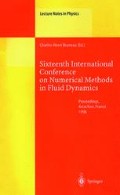Abstract
Using direct numerical simulations of turbulent channel flow, we present a new method for skin friction reduction by prevention of streamwise vortex formation near the wall. Instability of lifted, vortex-free low-speed streaks (above a critical strength ωyc) is shown to generate new streamwise vortices, which dominate near-wall turbulence phenomena. This new vortex formation mechanism consists of: (i) instability-initiated streak waviness in the horizontal plane, (ii) generation of thin horizontal sheets of streamwise vorticity and induction of positive stretching ∂u/ϖx (i.e. positive VISA), inherent to streak waviness, and finally (iii) vorticity sheet collapse via stretching (rather than roll-up) into streamwise vortices. The instability mechanism is explained and its evolutionary dynamics are documented. Significantly, the 3D features of the (instantaneous) instability-generated vortices agree well with the coherent structures educed (i.e. ensemble-averaged) from fully turbulent flow, suggesting the prevalence of this mechanism.
Based on this crucial role of streak instability in vortex generation, we develop a new technique for drag reduction, enabling large-scale flow forcing without requiring instantaneous flow information. As proof-of-principle, we show that an x-independent forcing, with a wavelength of 400 wall units and an amplitude of only 6% of the centerline velocity, produces a significant sustained drag reduction: 20% for imposed counterrotating streamwise vortices and 50% for colliding, z-directed wall jets. The drag reduction results from weakened longitudinal vortices near the wall, due to forcing-induced suppression of the underlying streak instability. In particular, the forcing weakens the wall-normal vorticity flanking lifted low-speed streaks, lowering it below ωyc, thereby arresting the streaks’ instability responsible for vortex generation. These results suggest promising new drag reduction strategies for practical situations, e.g. passive vortex generators or colliding spanwise jets from x-aligned slots, involving large-scale (hence more durable) actuation and requiring no wall sensors or control logic.
This research was supported by AFOSR grant F49620-97-1-0131 and the NASA Graduate Fellowship grant NGT-51022 of W.S. Supercomputer time was provided by the NASA Ames Research Center.
Preview
Unable to display preview. Download preview PDF.
References
Robinson, S.K. 1991 Coherent motions in the turbulent boundary layer. Ann. Rev. Fluid Mech. 23, 601.
Kline, S.J., Reynolds, W.C., Schraub, F.A. & Rundstadler, P.W. 1967 The structure of turbulent boundary layers. J. Fluid Mech. 30, 741.
Swearingen, J.D. & Blackwelder, R.F. 1987 The growth and breakdown of streamwise vortices in the presence of a wall. J. Fluid Mech. 182, 225.
Hamilton, J., Kim, J. & Waleffe, F. 1995 Regeneration mechanisms of near-wall turbulence structures. J. Fluid Mech. 287, 317.
Schoppa, W. & Hussain, F. 1997 Genesis and dynamics of coherent structures in near-wall turbulence. In Self-sustaining Mechanisms of Wall Turbulence (ed. R. Panton). Computational Mechanics Publications, p. 385.
Jeong, J. & Hussain, F. 1992 Coherent structures near the wall in a turbulent channel flow. In Proc. of Fifth Asian Congress of Fluid Mech., Taejon, Korea (eds. K.S. Chang & H. Choi), p. 1262.
Jeong, J., Hussain, F., Schoppa, W. & Kim, J. 1997 Coherent structures near the wall in a turbulent channel flow. J. Fluid Mech. 332, 185.
Schoppa, W., Hussain, F. & Metcalfe, R.W. 1995 A new mechanism of small-scale transition in a plane mixing layer: core dynamics of spanwise vortices. J. Fluid. Mech. 298, 23.
Hussain, F. 1986 Coherent structures and turbulence. J. Fluid Mech. 173, 303.
Kim, J., Moin, P. & Moser, R.D. 1987 Turbulence statistics in fully developed channel flow at low Reynolds number. J. Fluid Mech. 177, 133.
Jimenez, J. & Moin, P. 1991 The minimal flow unit in near-wall turbulence. J. Fluid Mech. 225, 213.
Jeong, J. & Hussain, F. 1995 On the identification of a vortex. J. Fluid Mech. 285, 69
Jimenez, J. & Orlandi, P. 1993 The rollup of a vortex layer near a wall. J. Fluid Mech. 248, 297.
Schoppa, W. & Hussain, F. 1998 A large-scale control strategy for drag reduction in turbulent boundary layers. Phys. Fluids 10, 1049.
Author information
Authors and Affiliations
Editor information
Rights and permissions
Copyright information
© 1998 Springer-Verlag
About this paper
Cite this paper
Schoppa, W., Hussain, F. (1998). Numerical study of near-wall coherent structures and their control in turbulent boundary layers. In: Bruneau, CH. (eds) Sixteenth International Conference on Numerical Methods in Fluid Dynamics. Lecture Notes in Physics, vol 515. Springer, Berlin, Heidelberg. https://doi.org/10.1007/BFb0106569
Download citation
DOI: https://doi.org/10.1007/BFb0106569
Published:
Publisher Name: Springer, Berlin, Heidelberg
Print ISBN: 978-3-540-65153-6
Online ISBN: 978-3-540-49540-6
eBook Packages: Springer Book Archive

